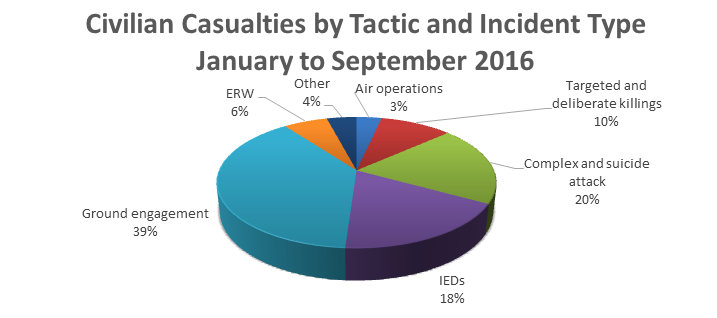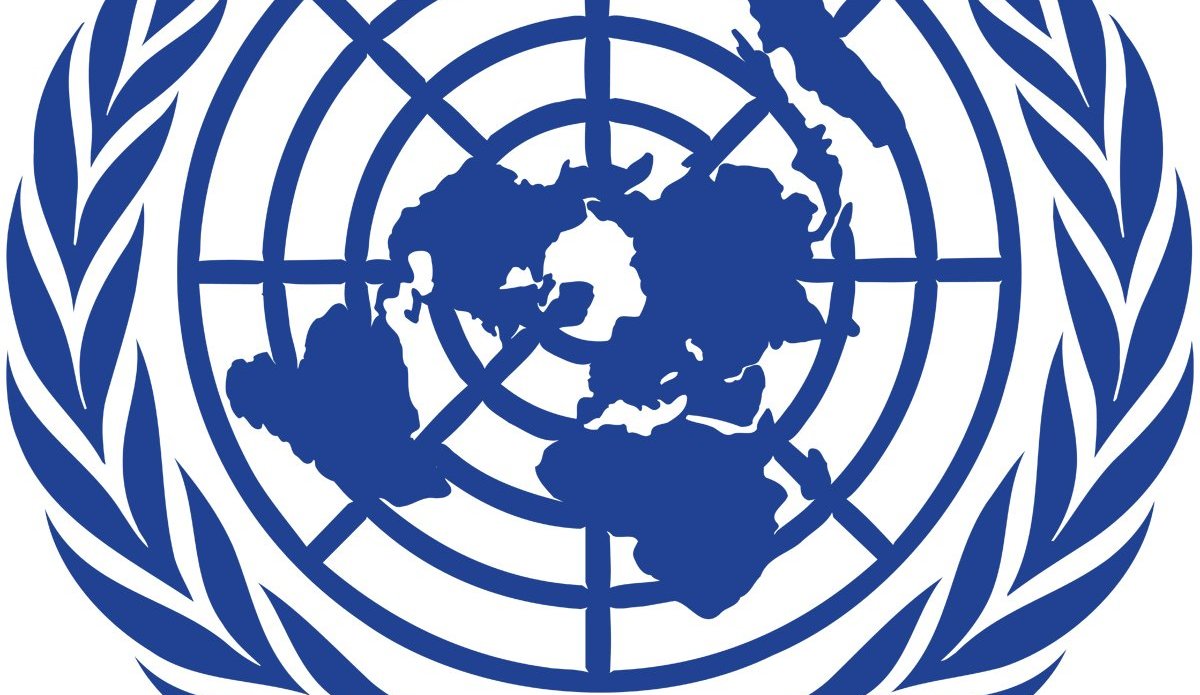UNAMA releases civilian casualty data for third quarter of 2016
KABUL - The UN Assistance Mission in Afghanistan (UNAMA) renews its call for all parties to refocus their efforts on preventing harm to civilians, as latest figures released today by UNAMA for the first three quarters of 2016 show continuing high numbers of civilian casualties from the armed conflict.
Between 1 January and 30 September, UNAMA documented 8,397 conflict-related civilian casualties (2,562 deaths and 5,835 injured) representing a one per cent decrease compared to the same period in 2015. Ground engagements remained the leading cause of civilian casualties, followed by suicide and complex attacks, and improvised explosive devices (IEDs).
“Increased fighting in densely populated areas makes it imperative for parties to take immediate steps to ensure all feasible precautions are being taken to spare civilians from harm,” said Tadamichi Yamamoto, the Secretary-General’s Special Representative for Afghanistan.

Anti-Government Elements caused 61 per cent of civilian casualties – 1,569 civilian deaths and 3,574 injured (5,143 total civilian casualties). While this represents a 12 per cent decrease from the same period in 2015 UNAMA continues to document Anti-Government Elements perpetrating illegal and indiscriminate attacks, as well as deliberate targeting of civilians.
UNAMA attributed 23 per cent of all civilian casualties to Pro-Government Forces, documenting 1,897 civilian casualties (623 deaths and 1,274 injured), representing a 42 per cent increase compared to last year – primarily due to casualties from the use of indirect and explosive weapons and aerial attacks.
Eleven per cent of civilian casualties resulted from ground fighting between Anti-Government Elements and Pro-Government Forces where the responsible party could not be identified. Unattributed unexploded ordnance caused the majority of the remaining civilian casualties (five per cent).

“There is an urgent need for the Government to implement the National Civilian Casualty Prevention and Mitigation policy and for Anti-Government Elements to cease the use of indiscriminate and illegal devices and tactics,” said Yamamoto, who is also the head of UNAMA.
UNAMA is deeply concerned by the continuing increase in child casualties, which have risen year-on-year since 2013. In the first nine months of 2016, UNAMA documented 2,461 child casualties (639 deaths and 1,822 injured), a 15 per cent increase on the same period in 2015. Ground engagements caused more than half of all child casualties in 2016.
The Mission documented 877 women civilian casualties (240 deaths and 637 injured), a 12 per cent decrease which is primarily due to fewer women casualties from suicide and complex attacks, as well as from IEDs.
Ground engagements between Pro-Government Forces and Anti-Government Elements caused 3,254 civilian casualties (829 deaths and 2,425 injured), accounting for 39 per cent of all civilian casualties. This marks an 18 per cent increase compared to the same period in 2015.
The intensification of ground fighting is directly related to the increase in civilian casualties from ERW, or unexploded ordnance. UNAMA documented 510 civilian casualties (160 deaths and 350 injured), a 67 per cent increase from the same period in 2015.
“Eighty-four per cent of victims from unexploded ordnance were children”, said Danielle Bell, UNAMA Human Rights Director. “All parties must systematically track, mark and clear unexploded ordinance in order protect current and future generations of children from harm.”
UNAMA identified notable decreases in civilian casualties caused by IEDs – 1,514 civilian casualties (496 deaths and 1,018 injured) amounting to a decrease of 22 per cent – and targeted killings – 835 civilian casualties (445 deaths and 390 injured) amounting to a decrease of 30 per cent.
Notwithstanding these decreases, attacks conducted by Anti-Government Elements directly targeting civilians or in areas with a large civilian presence continued. UNAMA recorded attacks intentionally targeting peaceful civilian demonstrators, educational facilities, judicial and media workers, as well as attacks conducted in civilian-populated urban areas including bazaars and religious facilities. On 23 July, Anti-Government Elements carried out a suicide attack in Kabul against a crowd of peaceful demonstrators, mainly of Hazara ethnicity, killing 85 and injuring 413. This was the deadliest single incident recorded by the United Nations in Afghanistan since 2001. Daesh (Islamic State in Iraq and the Levant) claimed responsibility for the attack. UNAMA reiterates that attacks directly targeting civilians may constitute war crimes and calls on all parties to the conflict to abide by international humanitarian law.
UNAMA also documented numerous conflict-related incidents targeting health-care and educational facilities, as well as humanitarian de-miners, polio vaccinators, and those providing humanitarian aid. Since 1 January 2016, UNAMA documented 75 incidents of attacks deliberately targeting education, including targeted killings, abduction of and threats against education personnel, and a suicide attack at the American University of Afghanistan on 24 August, which killed 13 civilians and injured 48. UNAMA calls on Anti-Government Elements to cease the deliberate targeting of civilians and civilian locations and to apply a definition of ‘civilians’ that is consistent with international humanitarian law.
UNAMA documented 1,897 civilian casualties (623 deaths and 1,274 injured) caused by Pro-Government Forces in the first nine months of 2016, a 42 per cent increase compared to the same period in 2015. The majority of civilian casualties caused by Pro-Government Forces occurred in the context of ground fighting with Anti-Government Elements.
UNAMA is similarly concerned by the rise in civilian casualties caused by aerial strikes by Pro-Government Forces, which accounted for 292 civilian casualties (133 deaths and 159 injured) between 1 January and 30 September 2016 - a 72 per cent increase from the same period in 2015. One third of these casualties were caused by international military forces.
UNAMA welcomes the Government’s continued efforts to strengthen the protection of civilians in the conduct of hostilities, including its approval of a national policy on civilian casualty mitigation. UNAMA reiterates its call to the Government to prioritize the execution of this policy, commencing with the completion of an action plan containing measurable objectives for its implementation.

***
For more detailed information, please consult the UNAMA annual and midyear reports on the Protection of Civilians in Armed Conflict that document the impact of the conflict on civilians in Afghanistan and include recommendations to protect civilians and civilian communities (available at: http://unama.unmissions.org/protection-of-civilians-reports). The next full report is expected in January 2017 and will cover the period 1 January to 31 December 2016.
 UN
UN







